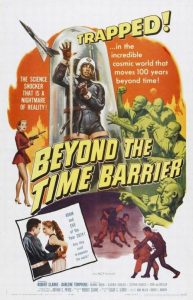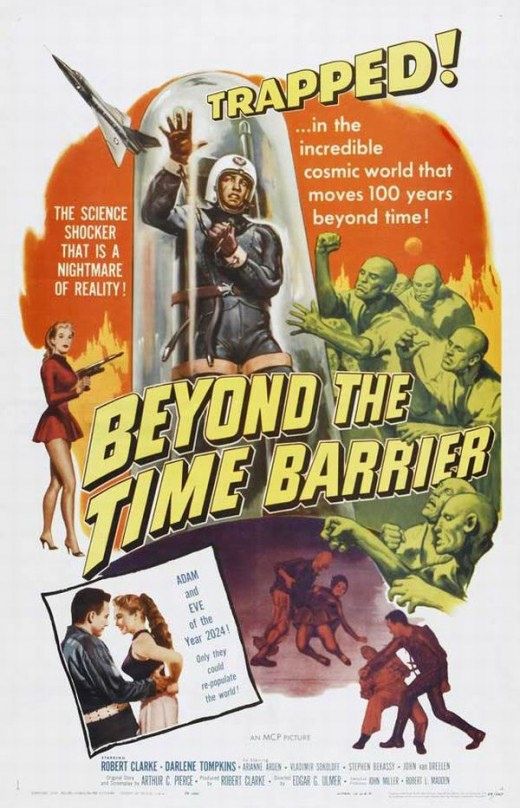
After the release of ‘Forbidden Planet’ in 1956, and before the release of ‘Planet of the Apes’ in 1968, the overwhelming number of science fiction films were ultra-low budget affairs, generally produced to fill out double-bills at drive-in theaters. I would posit that this period should be called the Golden Era of Schlock.
Schlock Scifi was not all bad…in fact, some of it was actually good, and a lot of it is interesting, and sometimes fascinating. There is a certain rough and ready charm to the earnestness and creativity of the actors, writers and directors, with some Schlock films being like the experience of watching community theater.
This film contains creative usage of a derelict airfield, filmed and edited to give the impression of a future of ruin and decay. The director also made good use of some strange architecture at the Texas State Fairgrounds, allowing the audience to make believe they are in fact seeing the underground dwellings of the future.
Stock footage of the F-102 ‘Delta Dagger’ fighter plane is used to represent an experimental rocket…and in an unusual move, the director actually had a miniature created that matched the stock footage…the FX are extremely primitive even by 1960 standards, but I have to give them credit for finding a model of an F-102, because usually these films just show stock footage of say, an A-4 rocket and then a model of a B-52 or something completely unrelated. (BTW, the F-102 is what former president George Bush flew when he was in the ‘Champagne Unit’ of the Texas Air National Guard, avoiding Viet Nam.)
There are some mildly scary screaming mutants here, who for some reason, the civilized people of the future keep in a huge dungeon inside their fortress, as opposed to a safer location outside the city. The mutants are bald and wear coveralls in close ups and medium shots…but when the camera looks down the stairs into the dungeon, the mutants have long hair and wear caveman clothes. Obviously, director Ulmer obtained some stock footage of the cavemen types and edited in to save money and time. The mutants yell a lot.
Robert Clarke is pretty decent as Our Hero the square jawed USAF pilot, and Darlene Tompkins is strangely charming as Tirene, the cute mute in the short skirt. In the city of the future, everyone is sterile except for Tirene…until the arrival or Our Hero. The Supreme Leader of the City of the Future, as well as Tirene, want Our Hero to impregnate Tirene so as to perpetuate the human race.
Apocalyptic Futures were in vogue during this era, but this film is unusual in that rather than forecasting an atomic war, it instead predicts Future Earth as a place where the atmosphere is gradually degraded from unrelenting atomic testing, and the human race is decimated by a series of plagues.
The idea of a time traveler visiting a post-apocalyptic future was fairly new at this point. The George Pal adaptation of The Time Machine, also released in 1960, touched on the subject, but only in passing, and was more concerned with evolutionary changes, rather than nuclear holocaust. This film certainly beat the el cheapo ‘Time Travelers’ (1964) as well as the big-budget ‘Planet of the Apes’ (1968) to the punch. Like those two films, this one also has a shock ending.
This film somehow manages to convey a mood of melancholy and anxiety, appropriate for the story of a man who learns that his world is going to hell. The subplot regarding his role as a sperm-donor, admittedly an adolescent male fantasy, is handled as plausibly as possible under the circumstances. Perhaps Gene Roddenberry was influenced by this film, since his 1964 unsold Star Trek pilot is also a story of a science-fiction sperm donor.
Many reviewers like to discuss ne’er-do-well director Edgar Ulmer’s style in this film. Certainly there are some elements of 1920’s German expressionism that help this film be a little more creepy and moody than it would otherwise.
In summary, this is a fun and interesting excursion into the land of Schlock, and it is better and more interesting than most Schlock…yet it was created as Schlock, and Schlock it will always be. View it in this context, and you will be happy.

